Monday, February 1, 2016
1958-59 New York Rangers Lou Fontinato Jersey
Lou Fontinato was a rugged defenseman who who played for the Guelph Biltmore Mad Hatters in junior hockey for two seasons, including a Memorial Cup championship in 1952.
The 1952 Memorial Cup champion Guelph Biltmore Mad Hatters
Following his junior career, Fontinato joined the Vancouver Canucks of the Western Hockey League in 1952-53. He would play for both the Canucks and the Saskatoon Quakers of the WHL in 1953-54 and then appear for Saskatoon, Vancouver and make his NHL debut with the New York Rangers, for whom he would appear in 28 games, scoring 2 goals and 4 points in 1954-55.
The following season the man named "Leapin' Louie", for his habit of either leaving his feet when he delivered body checks or jumping up and down when protesting penalties called against him, had plenty of chances to leave his feet either way, as he led the NHL in penalty minutes with a new league record when he became the first player to ever top the 200 minute mark with 202, leading Ted Lindsay by over 40 minutes and breaking Red Horner's 20 year old record of 167. He also set a career high that season with 18 points, as offense was clearly not his game.
Fontinato defending the Rangers goal
In 1957-58 he again led the league in penalty minutes with 152 after finishing second the year before.
During the following season Fontinato entered the realm of hockey lore when he was on the receiving end of one of the worst beatings during a fight in the history of the NHL at the hands of tough customer Gordie Howe. While Fontinato was an inch taller than Howe at 6' 1", Howe was thick as a brick and 20 pounds heavier at 205.
During the Rangers game against the Red Wings on this date in 1959, rookie Eddie Shack had been riling up the Red Wings as the Rangers built a 4-1 lead over Detroit. Tiring of his antics, Shack was cut by Howe to the tune of three stitches, which caused Fontinato to warn Howe to "lay off Shack and keep your stick to yourself." Howe and Fontinato already had a history together, as Fontinato had already split Howe's lip and taunted him in a previous game after which Fontinato nearly had his ear taken off by Howe in retaliation later on, as Howe had a reputation for never forgetting and always settling the score no matter how long the wait for the right opportunity.
When later in the game Shack was in a scrap with Detroit's Red Kelly, Howe joined the fight to help out his teammate Kelly and put Shack in his place when Fontinato came looking for him. Fontinato wasted no time in unleashing a fury of punches on Howe. Unfortunately for Fontinato, Howe remained conscious and was now incensed. He grabbed Fontinato's sweater with one hand and fired back repeatedly with the other. Howe connected with his first punch, which stopped Fontinato in his tracks. Howe's arm was described as "working like a piston" and the sound of his fist hitting Fontinato face again and again in rapid fire made a permanent impression on those who heard it - as well as Fontinato's face - with most descriptions of the blows comparing it to the sound of an axe chopping wood.
Howe and Fontinato during their infamous fight
Detroit's Lefty Wilson was quoted as saying "With every blow you could hear something break - squish, squish. Finally (the Rangers) Andy Bathgate jumped in and stopped it."
A wounded Fontinato is separated from Howe following their fight
Howe described the incident in his own understated way, "He was coming like a madman. It took me a while to get the gloves off and then things were busy."
Fontinato was left with a severely broken nose, now located a fair distance from it's original location. One of the linesmen described it as the worst beating he had ever seen anyone take, which came as a shock to all, as Fontinato had reportedly yet to have lost a fight, including having defeated Rocket Richard and Fern Flaman.
Fontinato after his encounter with Howe
Fontinato actually finished the game, but needed surgery to get his face back in working order, while Howe had actually dislocated a finger against Fontinato's skull while suffering a cut over one eye.
The fight was even documented with an article in Life magazine
At the conclusion of the season, as well as the next, Fontinato recorded the second highest penalty minutes in the league, meaning in his first five full seasons in the NHL, he had not finished outside the top two.
After one more season with the Rangers, Fontinato was traded to the Montreal Canadiens in exchange for future Hall of Famer and six time Norris Trophy winner Doug Harvey. Now protecting the likes of Ralph Backstrom, Claude Provost and Jean Beliveau. Fontinato immediately reclaimed his title as penalty minute leader with 167, over 50 more than the next highest though customer Ted Green.
Fontinato, with his repaired nose once again looking straight, while with Montreal
The 1962-63 season would prove to be Fontinato's last, as he would suffer a career-ending broken neck on March 9, 1963 against his old club, the Rangers, which left him paralyzed for a month and did not regain the feeling in his arms until four months later. One of the first people to call him at the hospital with encouragement was Howe.
In all, Fontinato played nine NHL seasons, leading the league in penalty minutes three times while at one point holding the league record. In his 535 games, he scored 26 goals, with a high of 7 in 1958-59, and 104 points.
Fontinato, alive and well, at Madision Square Garden in 2009 when the Rangers honored Harry Howell and Andy Bathgate
Today's featured jersey is a 1958-59 New York Rangers Lou Fontinato jersey. While the Rangers are famous for their blue sweaters, to the point the club is sometimes referred to as "The Blueshirts", having worn them since their inception in 1926, the Rangers white jerseys have also reached iconic status in the NHL in their own way.
First introduced in 1951, they remain essentially unchanged in now over 60 years. With their diagonal "Rangers" cresting and unique shoulder yoke treatment with the red striping contained inside the blue area, the Rangers added sleeve numbers in 1963 and names on the back in 1970.
After an ill-fated, brief change in style in 1976 for two seasons, the jerseys returned in 1978, only now with a v-neck collar. The next change for the white jerseys came in 1990 when the names on the back became vertically arched followed by the return of the original lace-up collar in 1999.
In today's video section, an interview with Fontinato and others about the famous fight.
Next, video of the crash into the boards which broke Fontinato's neck and ended his career. We warn you in advance, it's not for the squeamish and after seeing it once, we rather wish he hadn't, even knowing his injuries were not permanent.
Labels:
Fontinato Lou,
Howe Gordie,
New York Rangers
Subscribe to:
Post Comments (Atom)

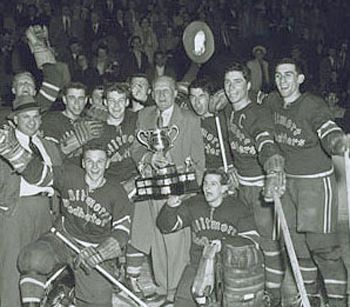
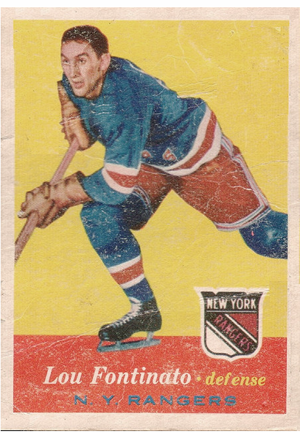
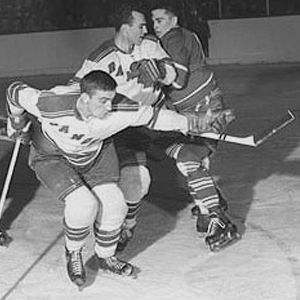


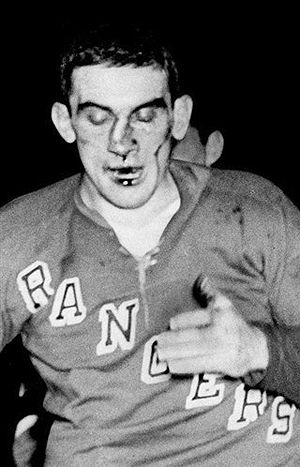
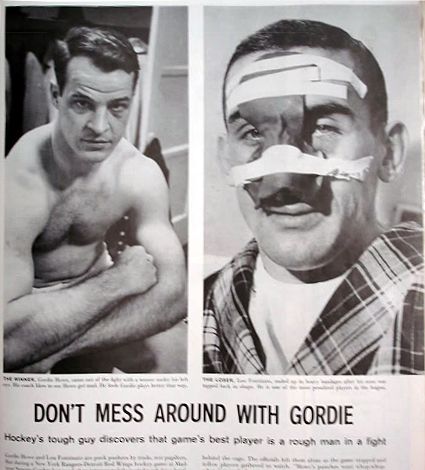
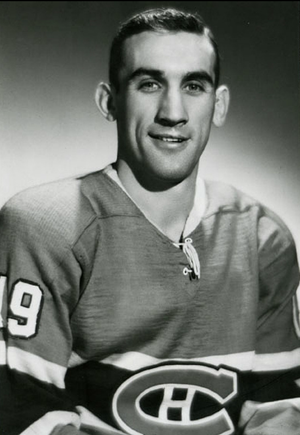

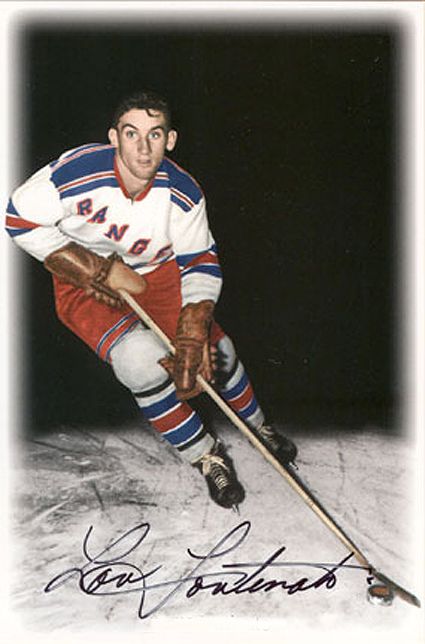










looks so much like ian laperriere
ReplyDeleteI was at the game with Howe/Fontinato fight. It was as recorded. Believe game also had an Andy Bathgate penalty shot scored against Hank Bassen.
ReplyDeleteWhat a historic game to be at. Great memories I'm sure. Thanks for sharing!
ReplyDelete